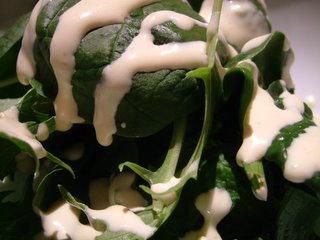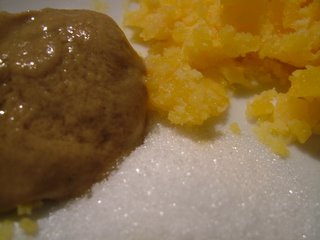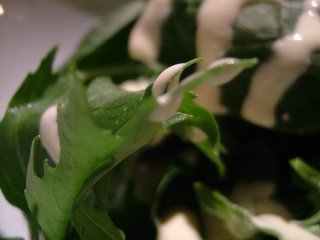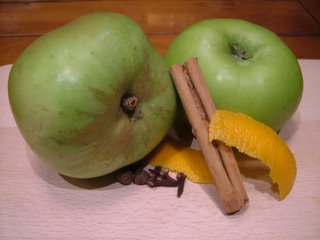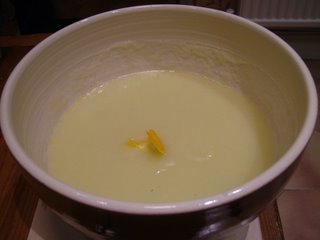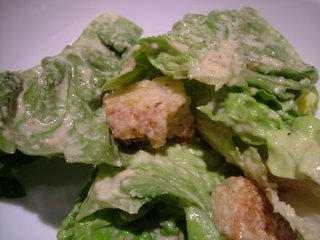 Poor Mr Weasel. While we were in America he fell in love with the Caesar salad at Friday’s Station, the steak house at the top of Harrah’s casino in Heavenly, Tahoe. (Review coming soon.) He’s been mentioning it with a hopeful glint in his eye since we came home.
Poor Mr Weasel. While we were in America he fell in love with the Caesar salad at Friday’s Station, the steak house at the top of Harrah’s casino in Heavenly, Tahoe. (Review coming soon.) He’s been mentioning it with a hopeful glint in his eye since we came home.
He’s had a bad day – he’s had to take the cats to the vet to be neutered. (Not moment too soon; Raffles has been demonstrating some pretty remarkable feats of anatomy since we came back from holiday, and has also become rather territorial, facing off with the new fridge and posturing in a macho fashion around visitors and delivery-men.) Mooncake is being surprisingly bouncy for someone who’s just had her ovaries whipped out and half her fur shaved off. I think this is what comes of not having a pelvic floor. Here they are, Mooncake in the front, demonstrating her newly shaved beard.
 The whole thing was clearly rather stressful for Mr Weasel, who currently seems unable to look the emasculated Raffles in the eye. He ran out of the house at five o’clock under the pretext of going to a friend’s house to do some analogue electronics. I took the opportunity to try to reproduce the salad as a surprise for his dinner.
The whole thing was clearly rather stressful for Mr Weasel, who currently seems unable to look the emasculated Raffles in the eye. He ran out of the house at five o’clock under the pretext of going to a friend’s house to do some analogue electronics. I took the opportunity to try to reproduce the salad as a surprise for his dinner.
Caesar salad is named for Caesar Cardini, the Italian chef working in Mexico who came up with the recipe in the 1920s. A Caesar salad in some American restaurants can be quite a performance, with the dressing being whipped up at the side of the table (Judy Garland fans will be familiar with this from Easter Parade, an otherwise marvellous film which reaches a nadir in the scene where a particularly odious French waiter prepares a Caesar-type salad in mime). I am lazy and use the Magimix.
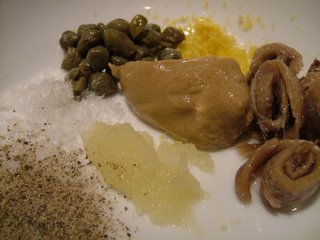 The original recipe does not include anchovies, but the delicious salad from Friday’s Station had them in the dressing, and you’ll find them in my recipe. You’ll need:
The original recipe does not include anchovies, but the delicious salad from Friday’s Station had them in the dressing, and you’ll find them in my recipe. You’ll need:
Croutons
1 soup bowl of bread cut into cubes about 2cm per side
4 grated cloves garlic
1 handful grated parmesan
2 tablespoons olive oil
Dressing
Zest and juice of 1 lemon
1 large clove of garlic, crushed
1 teaspoon Dijon mustard
1 teaspoon Worcestershire sauce
1 teaspoon capers, rinsed
5 anchovies
1 coddled egg (put the egg in briskly boiling water for 60 seconds, then fish out and leave to cool)
1 tablespoon double cream
Salt and pepper to taste
100ml extra-virgin olive oil
1 handful grated parmesan
2 cos lettuces, torn into pieces
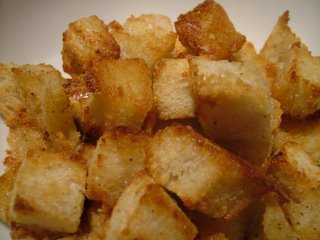 Start by making the croutons. Mix all the ingredients in a large bowl, spread them in one layer on a baking sheet, and bake at 200°C until golden (about ten minutes – keep an eye on them from eight minutes in to check that they don’t over-colour). Set aside.
Start by making the croutons. Mix all the ingredients in a large bowl, spread them in one layer on a baking sheet, and bake at 200°C until golden (about ten minutes – keep an eye on them from eight minutes in to check that they don’t over-colour). Set aside.
Put all the dressing ingredients except the olive oil and parmesan in the bowl of a food processor and whizz until you have a smooth paste. With the machine on and the blades spinning, drizzle the olive oil into the mixture – it will emulsify with the other ingredients and create a creamy dressing.
Toss the lettuce and croutons with the dressing and parmesan. Serve immediately so the croutons and leaves don’t go soggy. Guzzle, and congratulate yourself that it’s not necessary to cross the Atlantic to get a good Caesar salad.
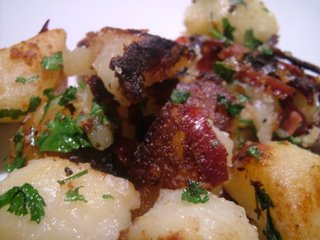 King Edward potatoes are in the shops at the moment; they’re my very favourite potato for frying and roasting flavour and texture. Extremely floury, they roast and saute to a beautiful crisp, and they also mash beautifully.
King Edward potatoes are in the shops at the moment; they’re my very favourite potato for frying and roasting flavour and texture. Extremely floury, they roast and saute to a beautiful crisp, and they also mash beautifully.





